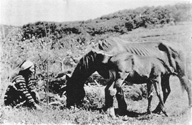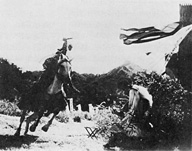| Films about Yamagata |
|---|
|
|
Part 4 Yamagata Odeon
Nowadays, narrative films shot on location in Yamagata get released nearly every year, but it would appear there were not that many works shot in Yamagata before the war. Horse and The Battle of Kawanakajima, which will be screened this year, are set in Morioka and Shinshu, which begs the question: Why was filming done in Yamagata?
Here is what Kinugasa Teinosuke, the director of The Battle of Kawanakajima, had to say in one of the movie magazines at that time:
I particularly chose Yamagata and Akita in the Tohoku region as the location this time because the terrain of Omagari in Akita and Kashiwagura-Monden, Yamadera, and Takayu in Yamagata provided favorable conditions for The Battle of Kawanakajima; also, the region is known for horse breeding, which would be an advantage in shooting the cavalry battles. But another, more important factor was the very local freshness of the Tohoku region in all aspects of climate and customs, with none of the old familiarity of the Kanto and Kansai regions where we have been producing period dramas up until now, and I wanted to capture something of this in The Battle of Kawanakajima. (Eiga no Tomo, October 1941)
The horse breeding and the local freshness were also presumably why Horse was partially shot in Yamagata. I hope to discover in these films the “fresh Yamagata” of sixty-six years previous.
—Saito Hisao
 Horse
Horse
(“Uma”)- 1941 / Japanese / B&W / 16mm (Original: 35mm) / 129 min
Director, Script: Yamamoto Kajiro
Production Manager: Kurosawa Akira
Photography: Karasawa Hiromitsu, Mimura Akira, Suzuki Hiroshi, Ito Takeo
Editing: Sato Toshio
Sound: Higuchi Tomohisa
Music: Kitamura Shigeaki Lighting: Onuma Masayoshi
Cast: Takamine Hideko, Fujiwara Keita, Takehisa Chieko, Futaba Kaoru, Hirata Takeshi
Production Companies: Toho, Cinema Science Laboratory
Source: Toho
Set in an agricultural village in Tohoku, this film depicts the close relationship between a horse and a young girl. While this patriotic story about raising a military horse was in line with national policy (whipping up war sentiment) at the time, Yamamoto Kajiro’s semi-documentary-style direction—evident, for instance, in the familiar sights of an agricultural village during the changing seasons as visualized by the four cinematographers—is striking. Takamine Hideko is excellent in the lead role as the young girl, and Kurosawa Akira, who served as a kind of assistant director on this project, is said to have directed a number of scenes. While most of the filming was done in Morioka City, Iwate Prefecture, the snow scenes were among those shot in Shinjo and Mogami, Yamagata Prefecture.
 The Battle of Kawanakajima
The Battle of Kawanakajima
(“Kawanakajima kassen”)- 1941 / Japanese / B&W / 16mm (Original: 35mm) / 120 min
Director: Kinugasa Teinosuke
Production Managers: Mori Hajime, Kusuda Kiyoshi
Original Story: Muneta Hiroshi
Script: Muneta Hiroshi, Kinugasa Teinosuke
Photography: Miura Mitsuo
Editing: Iwashita Koichi
Art Director: Matsuyama Takashi
Sound: Yasue Shigeharu
Music: Yamada Kosaku
Lighting: Fujibayashi Ko
Cast: Ichikawa Ennosuke, Okochi Denjiro, Hasegawa Kazuo, Irie Takako, Yamada Isuzu
Production Company: Toho
Source: National Film Center
This epic depicts the battle between Uesugi Kenshin (Ichikawa Ennosuke, later Ichikawa Eno) and Takeda Shingen (Okochi Denjiro). The focus of the story is the struggle by the unit leader in charge of the main supply wagons (also played by Ichikawa Ennosuke) and the supply troops (Hasegawa Kazuo among them) to transport materiel to the Uesugi army. To this are added episodes involving an itinerant woman (Yamada Isuzu). Shooting went ahead on location in the summer of 1941, and all the big stars, including Hasegawa Kazuo and Yamada Isuzu, descended on Yamagata, apparently creating quite a stir at the time. Filming took place in Tendo, Yamadera, Takayu, Hirashimizu, Kashiwagura-Monden, and Kaminoyama, among other places.
